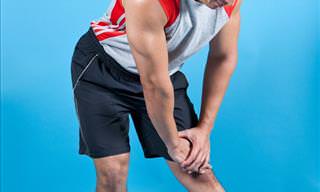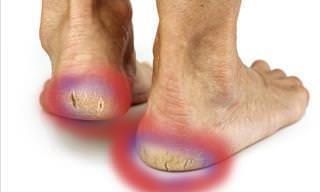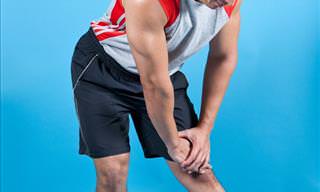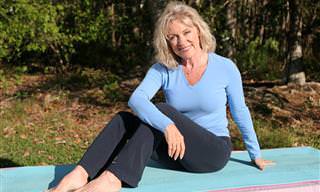In our younger years we often take our balance for granted. But for anyone who has ever lost their footing, losing your balance can be pretty frightening. Our balance tends to decline as we age, primarily due to weaker hips and legs which make it harder to walk (try these 12 great leg strengthening exercises) as well as poor posture and an inability to lift our feet, which can often cause us to stumble.
Did You Know? When we rise from a chair, climb stairs and walk outside on uneven terrain, there is cooperation between the brain, nervous system, muscles and bones that keeps us from falling. Balance activity and elderly balance exercises can reduce falling over and improve your performance. Training your body balance can improve your overall upper and lower body strength. These exercises will challenge your balance system with activities that require the use of the brain, nervous system, muscles and bones.
Before You Start: While balance exercises are fun, they can also be challenging. When performing these exercises have a helping hand to hold, this will allow you to better focus on maintaining your balance as you get used to the exercises.
Disclaimer: These exercises are intended for normal imbalance and unsteadiness in seniors due to inactivity and disuse. If you suspect a more serious balance problem, involving vertigo, ear infections, Meniere's disease, chronic dizziness or drug interactions, consult with your doctor.
1. Single Limb Stance
Benefits:
• This exercise will train your brain to become more aware of where your center of gravity is located.
• It will strengthen your ankles and hips for improved stability.
Instructions:
• Stand by a chair with your feet together and arms at your sides.
• Lightly holding onto the chair, lift one leg up and balance on the other.
• Hold for 10 seconds and repeat with the other leg.
• Maintain a steady, normal breath. Breathing in through the nose and out through the mouth.
• For a little extra challenge, look straight ahead.
Tips:
• Use a chair to hold onto while standing. Depending on how comfortable you feel with balancing on one leg, hold onto the chair with your finger, one hand or two hands.
• Throughout the exercise, don't close your eyes or hold your breath.
• If you are not using the chair for any support, but would like to maintain a little extra balance, hold your arms out to the sides.
2. Eye Tracking
Benefits:
• Eye tracking exercises help our visual and vestibular systems.
• They are also important in maintaining our postural ability.
Instructions:
• Hold your thumb comfortably in front of your face with your elbow bent.
• Move your thumb to the right as far as is comfortable.
• Move your thumb to the left as far as is comfortable.
• Try not to move your head - follow your thumb with your eyes only.
• Repeat the exercise, this time moving your thumb upwards, then downwards.
Tips:
• Keep your chest lifted, neck long, chin parallel to the floor, shoulders away from your ears.
• If you get dizzy, stop. Should you wish to try again, hold onto a chair.
3. Clock Reach
Benefits:
• Clock reach helps improve your static or standing balance.
• It also strengthens your ankles and hip muscles while adding to your shoulder and upper body range of motion.
Instructions:
• Hold onto a chair with your left hand.
• Visualize a clock with 12 in front of you and 6 behind you.
• Stand on your left leg and bring your right arm to 12 o'clock. Reach to 3, then 6 o'clock.
• Repeat on the other side, standing on your right leg.
• Keep your breath normal, inhaling through the nose and exhaling through the mouth.
Tips:
• Lift your chest and stand tall.
• Keep your gaze fixed on a point, at eye level.
• Reach out as far as you feel comfortable.
• If reaching to 6 o'clock is painful, stop at 3 o'clock.
4. Staggered Stance
Benefits:
• This exercise will help improve our static or standing balance.
• It strengthens our ankles for greater ability to maintain our center of gravity.
Instructions:
• Begin with your feet together, hands at your sides.
• Step forward with your right foot and hold this position for 10 seconds.
• Alternate, this time with the left foot in front.
Tips:
• Keep your gaze fixed on a point in front of you.
• If needed, hold on to a chair.
• For more accuracy, practice with tape on the floor.
5. Single Limb with Arm
Benefits:
• Besides improving static, or standing balance, this exercise improves our leg, hip and arm strength.
• It also orients us to maintaining our center of gravity over our ankles.
Instructions:
• Stand with your feet together, arms at your sides.
• With your right hand, hold onto a chair for support if needed.
• Raise your left arm over your head, and raise your left leg off the floor.
• Hold for 10 seconds, and repeat exercise, with your right arm and your right leg.
Tips:
• Maintain a steady, normal breath - breathing in through the nose and out through the mouth.
• Depending on your level of stability, hold onto a chair with your finger, one hand or two hands.
• Keep your eyes focused on a point for better balance.
6. Knee Marching
Benefits:
• Knee marching will strengthen your ankles and hips.
• It will also improve your dynamic or moving balance.
Instructions:
• Stand with your arms at your sides, feet shoulder width apart.
• Raise one knee up as high as comfortable.
• Lower, then raise the other knee. Repeat for a total over 20 times.
• Throughout the exercise breath normally, inhaling through the nose and exhaling through the mouth.
Tips:
• Use a chair for extra support.
• For extra balance, raise your hands out to the sides.
7. Body Circles
Benefits:
• Body circles will enhance the work that your ankles need to do.
Instructions:
• Stand with your feet, shoulder width apart, hands at your sides.
• Keep your body straight and slowly sway in a circle.
• Continue for 1 minute, ensuring that you breathe normally throughout (in through the nose, out through the mouth).
Tips:
• Stop the exercise if you get dizzy.
• Keep your body straight.
• If you need more support, hold your arms out to the sides.
8. Heel to Toe
Benefits:
• This exercise improves balance with narrow stance position.
• It also assists your dynamic or moving balance.
Instructions:
• Begin by standing with one foot in front of the other.
• Step forward, placing one foot in line with the other.
• Continue moving forward, placing the right foot in front of your left, left in front of your right.
• Retain a normal breath throughout the exercise, inhaling through the nose, exhaling through the mouth.
Tips:
• This is the hardest exercise on the list and should be attempted when you feel comfortable enough to hold your balance without the support of a chair.
• As a first attempt, try this exercise in your kitchen, holding onto the kitchen counter for support.
• Alternatively, you may hold someone's hand.
• Once you can manage on your own, use a tape on the floor to guide you in the exercise.
Source: eldergym
 Go to BabaMail
Go to BabaMail



















































